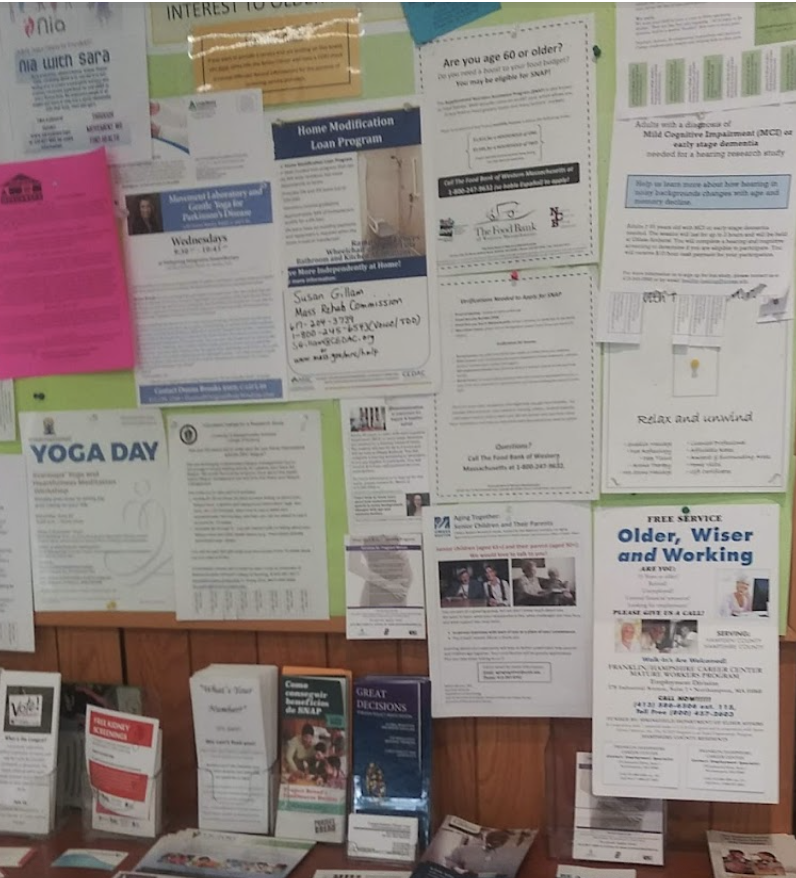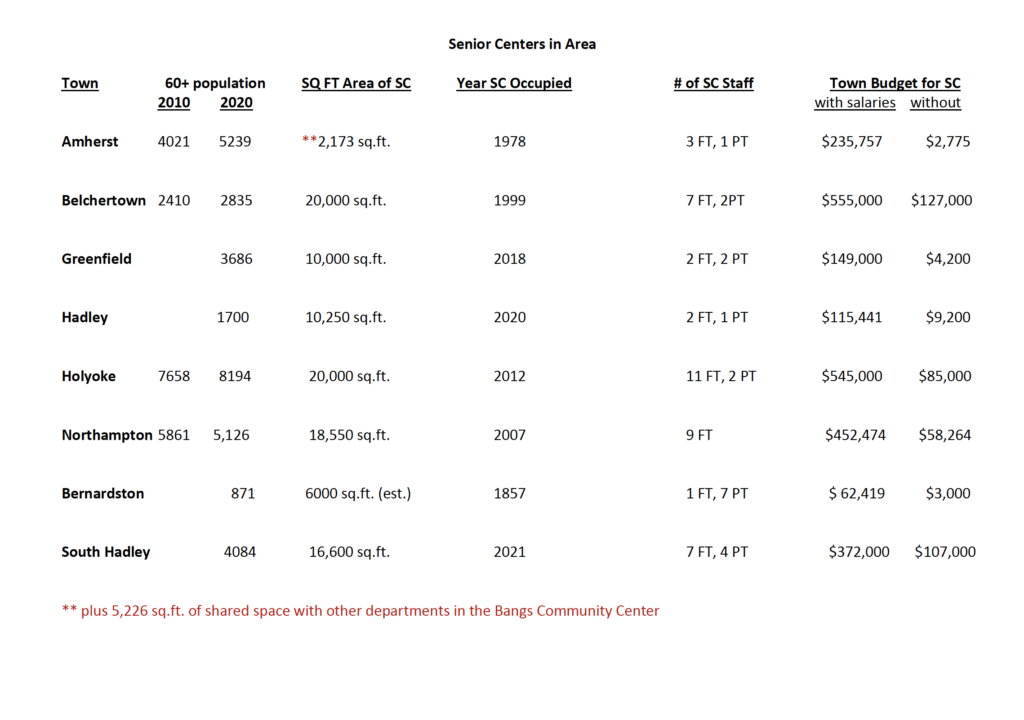Letter: Senior Center Lacks Necessary Space, Budget, And Staffing To Meet Needs Of Amherst’s Older Residents

A bulletin board at the Amherst Senior Center. Photo: amherstma.gov
The following letter was sent to the Amherst Town Council on April 4, 2022. It was signed by nine members of Friends Of The Amherst Senior Center.
We thank you all for your service to the community and for your important work toward achieving town goals, community growth, and strategic planning.
We want to share a concern we have and want to raise your awareness of what is an increasing problem at the Amherst Senior Center. We are concerned about the limited space the center has for programs and classes.
Now that COVID restrictions are lifted and the doors to the senior center are once again unlocked, classes, programs and services can be resumed. Yet, we are struggling to find sufficient classroom space for those activities. The large room that was once used for health-supporting exercise and dance classes is now being used by the Town to store the Civil War Tablets. Some of the dance and exercise classes can meet in the large lunchroom but scheduling for that room is limited because it is used for four hours during the middle of the day for lunch distribution or congregate lunch. There are only two modest-sized classrooms and one small classroom that can be used for all programs – food distribution, education classes, computer tutoring, Shakespeare class, numerous dance & exercise classes, Yoga, Tai Chi, support group meetings, cribbage, bridge, health clinics, and more.
Currently, there are 5,239 seniors over the age of 60 in Amherst. The classes, services and programs at the senior center are critical to many of those elders. Like everyone, they have been living an isolated existence for years due to COVID restrictions. The impact of isolation, especially for the majority who live alone has been crippling, and the impact is even greater for those who do not drive, are not technologically capable and cannot afford a private gym membership. The result can lead to loneliness, anxiety, depression and even failing health. The senior center is a safety net for those folks. It becomes like a second home as they rely on the center for social activity, exercise classes to keep fit, nutrition, age-related information, mind-stimulating games and more. Those programs and activities help to keep elders active and able to age in place. The need for socialization and human connection is extremely important for all older adults.
The solution to the space problem may not be simple. However, to acknowledge that the problem exists and to make others aware of it is the first step. We invite each of you to tour of the Senior Center to get a better sense of the space limitations.
Several of us have looked at how the Amherst Senior Center space compares to other senior centers in the area. The attached document is rather revealing in several categories. As you will see, in addition to a lack of space, the senior center also lacks budgetary support and staffing compared to other centers in the area.
The purpose of the programs and services at the Amherst Senior Center is to enhance dignity, support independence, maintain health and strength, and promote the involvement of older adults in the community. These goals cannot be met with inadequate space, inadequate staff and an inadequate budget.

Richard Yourga, President rcyourga@aol.com
Dennis Vandal, Secretary
Mary Elmer, Treasurer
Barbara Slovin
Norma Hallock
Kay Weinberg
Rosemary Kofler
Mary Hough
John Magarian
The signatories are members of Friends Of The Amherst Senior Center

for quite a number of years there have been discussions of moving the Amherst Senior Center from it’s present location. but where it is located is PERFECT. yes it may be smaller than what some residents would prefer. and yes some residents would appreciate more parking. but I feel the present location addresses the needs of elderly residents living in Ann Whalen and Clarke House well. making do with the building so centrally located in town IS sensible and workable.
I appreciate this letter and the benchmarking table which compares Amherst’s Senior Center to neighboring towns.
I also appreciate Emilie Hamilton’s comment about the Bangs Center location being ideal for residents of Ann Whalen and Clarke House.
One idea I wanted to put out there and get feedback on is if one of the elementary school locations might be a suitable alternative or supplementary Senior Center space?
While a school building would not be available until 2026, Fort River and Wildwood schools are expected to be consolidated into one building at that time which will leave the other building and site vacant and available for town uses. They are large, identical buildings at 82,000 square feet, with twelve 2,000sf classrooms plus many other rooms of about 1,000sf each, a gymnasium, cafeterias, kitchen, multiple office spaces, and plenty of parking, as well as outdoor green space. Perhaps some of the Senior Center programming could be offered in some of these spaces?
If this was to be pursued, would either the Wildwood or the Fort River location be better for our seniors? The Wildwood site would offer the opportunity for co-locating a Senior Center/Satellite Senior Center alongside a BIPOC Youth Center and/or Multicultural Center, and potentially an Early Childhood Center or expanded Head Start programs, allowing for inter-generational programming which Hayley Bolton has said is a goal. There are also other potential complementary uses like ESL programming and Amherst Recreation programming. The sky’s the limit as there is a large amount of space in the buildings.
If anyone thinks this idea is worth pursuing, and one site would be better than the other for a Senior Center, now is the time to raise it with your Councilors, the Town Manager, and/or the Elementary School Building Committee, as the latter will be selecting the site for the new school in the next few weeks.
I heartily support Toni Cunningham’s idea of using one of the sites for intergenerational programs. I understand that the adjacency of Bangs to the Whalen and Clarke houses is appealing, but for the many seniors who do not live downtown it is much less appealing, and the lack of space is determinative, I think.
I advocated for moving the general circulating collection of the Jones to one of the school sites and sharing it with the Senior Center, but that idea landed with a thud. I have assumed that the Town has its eye on Fort River for some other use but if that is not the case I think it would be a grand site for the Senior Center and some of the programs Toni named. Wildwood has the advantage of adjacency to the Middle and High Schools, but otherwise I see no difference between the two for intergenerational use. The ease of parking and access at both sites are hugely better than at either the Bangs Center or the current Jones site.
Now or soon would be the time to have a town-led community discussion about the pros and cons of future uses for either Wildwood or Fort River. Too often in Amherst (and Earth) decisions are made discreetly and prematurely, and then anyone with other perspectives are characterized as naysayers.
It seems wise, as stewards of the town, to have a community use that also serves to land-bank the property for future needs. When I had a business in Freeport, NY I was on a committee to decide which of 5 elementary schools to sell off. The majority of the committee rejected the idea that the land may be needed for public use one day, an do not sell it to the ABC Hangar and Supply Company. And lo, a 5th school was needed, but the building and land was not available.
How many houses could fit on the Wildwood property, along Strong Street? If you could squeeze in 5, it would add to the shitshow of that intersection, but aside from that, each house would pay about $8000 in town taxes, so for $40,000 per year, we’ve lost an important resource.
I only give that example because I’ve heard from more than one person who seems in the know that those discussions have already happened, about selling the abandoned school for houses. I’ve also heard they haven’t, from the person who was quoted as discussing it.
On first consideration it would seem a good idea to have a community center adjacent to a city’s higher rise housing facility. Deciding to follow through with the idea might have the unintended consequences of restricting movement for limited income (elderly, handicapped of any age). Unfortunately that appears the case here in our city. A second consequence is that of identity. Several recent surveys of city service (Age Friendly), health (UMass) have shown that a majority of the city’s residents in the “Senior Center age cohort’ do not see the center as there for them. They see it for those of lower means.
Architecture is a human science and as such we have learned that the built environment effects us. Citing (a village center wishing to have a 21st century community center or senior center located there) on the transportation corridor, construction in the New England vernacular, having transportation for the interested can mean something very different than the available by default we’ve had of the last 50 years.
Viewing from this perspective allows one to see that the older people in the community (whether of means or not) have not gotten the same resource the other group of age discriminated folks in the city have (the youngest). I appreciate the publication of that fact by those currently doing so. I also have a description of the 21st century best practices model (named above) for those interested. Some have been located next to schools but the programing must flow from the community , not the city as now exists. Amherst continues to be cited for transparency and communication difficulty by citizens, boards, commissions, committees. Competition is the bane of an integrated program. There is too much at this point. I’m posting about the fact that larger group decisions prove to work better & be comprehensive compared to ones by just several main players. Decisions by the few and holding resources close to the vest and dolling out bits and pieces has created “the six big projects” we now have.